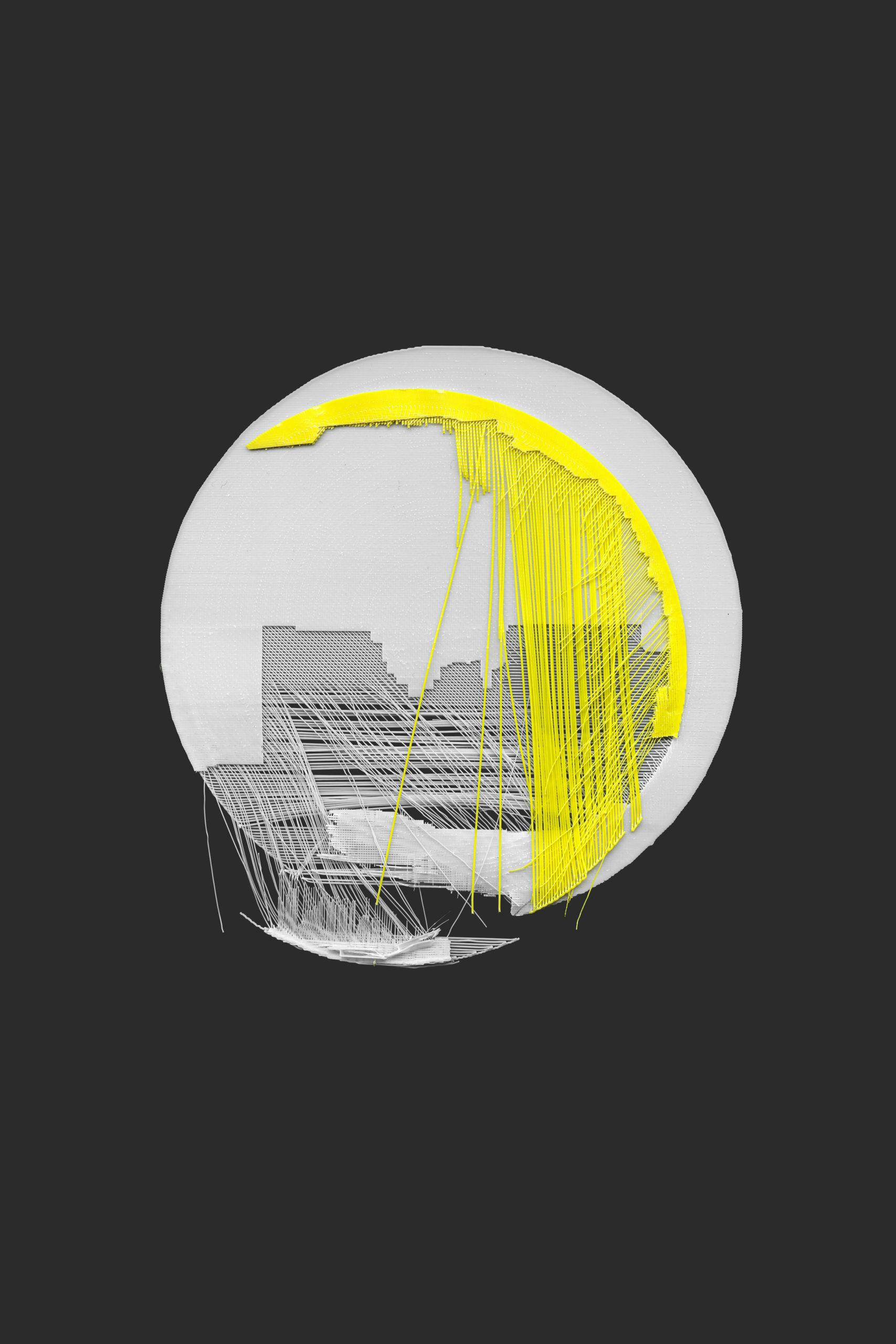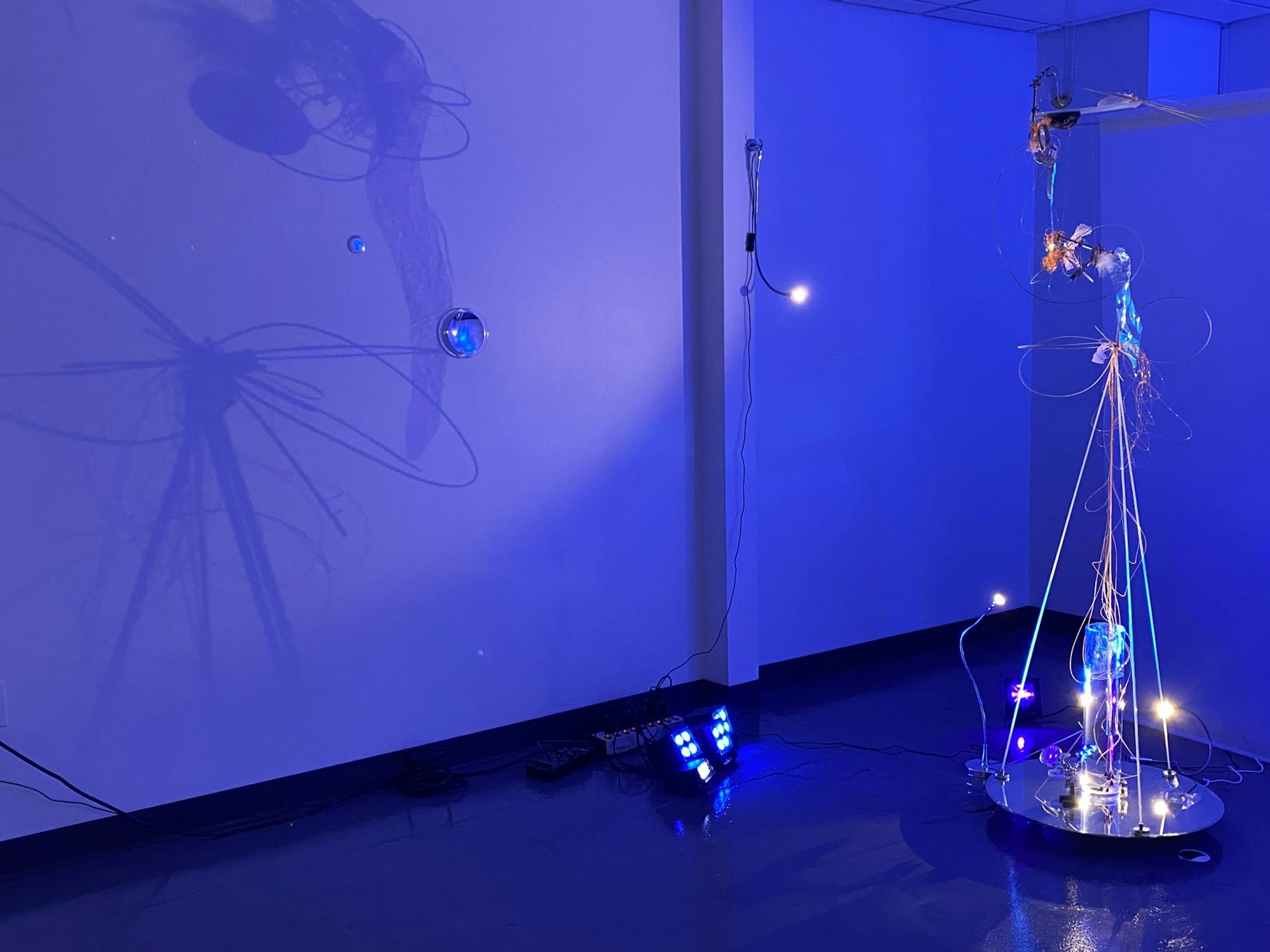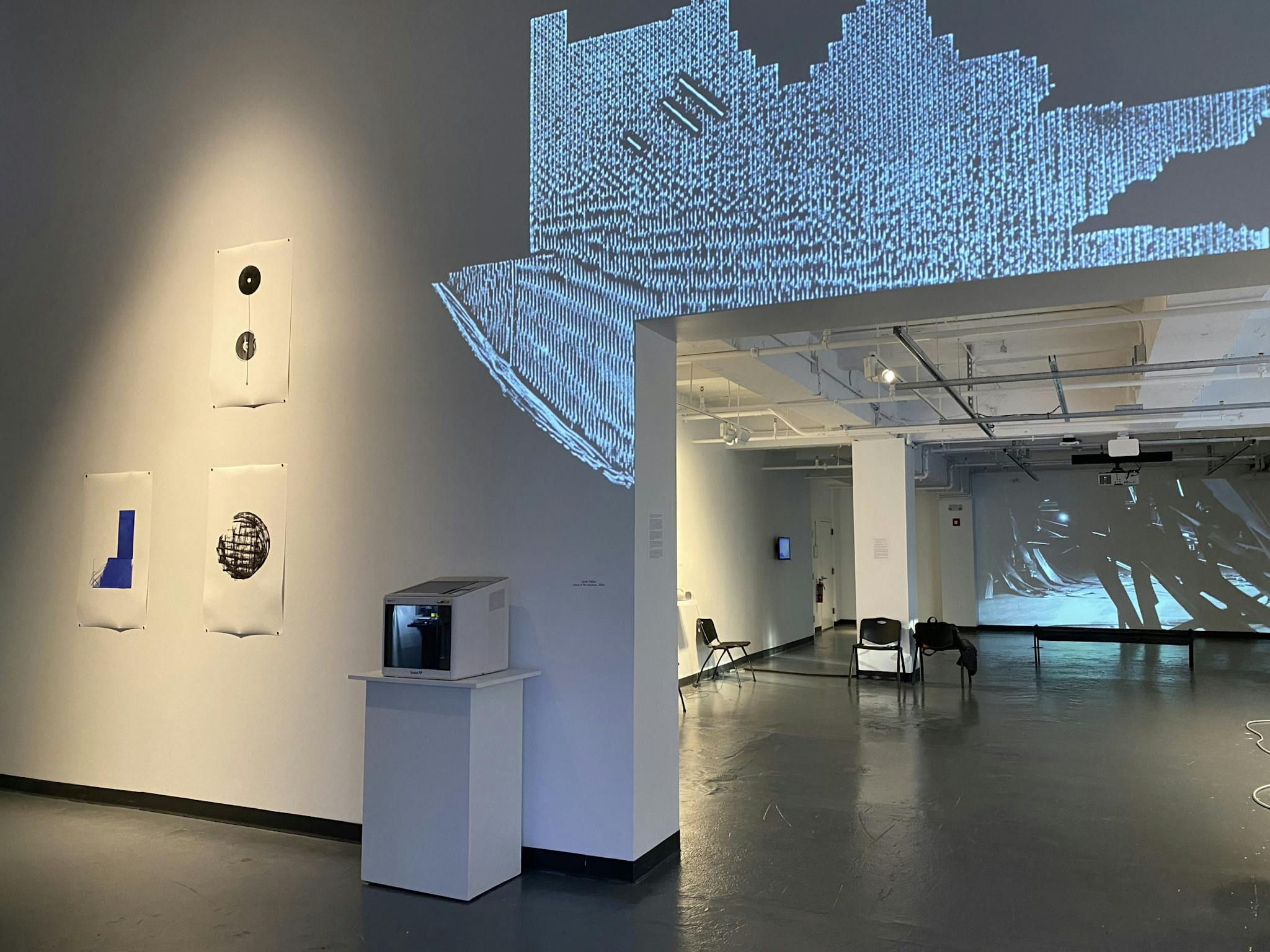In the stark white spaces of the Emerson Contemporary Media Art Gallery—lined on one side with large glass windows—moving projections climb walls, a robot shimmies across a gray polished floor, and a sculpture spins in a surveilled room to the sound of a babbling brook. These works and more make up the “Spacetime (x,y,z + t)” exhibition featuring experimental pieces that explore time and space through technology. Curated by Emerson College’s Foster Chair of Art Theory and Practice and Distinguished Curator-in-Residence, Leonie Bradbury, the collection highlights interactions between the virtual and the real, challenges gallery-goers’ perceptions with durational elements, and urges visitors to engage with 3D-printed objects, VR drawings, video and more.
The show’s title is inspired by Albert Einstein’s assertion that space and time aren’t separate entities, but rather “are part of a four-dimensional continuum,” Bradbury explains as we walk around the gallery. “So, when an object is traveling through space, we can’t just consider its physical coordinates like X, Y and Z. We also have to think of T, that time coordinate, as being part of locating the objects.”
Time might be the most challenging aspect of the boundary-bending exhibit. Technology makes staying in touch easier, and just about everything else from shopping to working faster. However, “Spacetime” isn’t a show to quickly breeze through.
Even if that’s the plan, there are no wall texts accompanying the “Spacetime” pieces. Instead, Bradbury wants visitors to choose their own adventures and immerse themselves in the art. Handouts are available at the front for the curious, but walking through without one (at least the first time) proves to be a worthwhile endeavor.

Zsuzsanna Szegedi, In the Fracture installation view, video simulation, 2018-2019. Image courtesy of Emerson Contemporary.
Close to the gallery’s entrance, Hungarian-born artist Zsuzsanna Szegedi’s “In the Fracture” contends with the power dynamics between man and machine using a 3D scan of her face as an entry point. Szegedi thinks a lot about the information stored in the body and the struggle to find the language to express it. That’s partly why fractures—and what they carry—intrigue her.
Before her artist talk, “In Conversation: Investigating the Material,” Szegedi meets me at a Downtown Crossing coffee shop around the corner from the gallery. While there, she lifts up her iPhone to take a panoramic photo and intentionally jostles the camera. The movement produces a thick, jagged break in the shot. Szegedi creates this tension in her work to study it, she explains.
“This is really a fault line that allows things to move, right?” she asks. “And I’m looking at the location and the behavior of the spectrum; and then the fact that I’m inducing it and the camera is trying to correct it, and suddenly I’m here with the camera realizing the power dynamics. [And I think] wait, so who’s winning…?”
To produce the desired effect for her “Spacetime” piece, Szegedi intentionally disrupts the scanning process by stepping out of the frame. To compensate for this, the software substitutes scaffolding for the missing parts. The resulting work is a black sculpture of her face turned upside down that appears to be held in place by the 3D-printed scaffolding.
Szegedi provides multiple ways to view “In the Fracture”—there’s projections of the image file on a large piece of raw clay and on a diagonal wall nearby—so that audiences can find their place within it. “The analysis of these entry points” is the whole idea of the piece, Szegedi says. She uses her face because it’s “the closest, most vulnerable representation of me.” Through her work, Szegedi says, she seeks to discover the capacities of technology to hold our truths. Up close, the artist’s face slowly drifts by on the ever-shrinking clay mound if the viewer waits for it.

Sarah Trahan, Hand Of The Machine, archival inkjet print, 2020. Image courtesy of the artist.
Like Szegedi’s work, imperfections anchor Sarah Trahan’s multimedia “Hand of the Machine,” too. Trahan, who is trained as a photographer, uses build plates left over from 3D-print jobs and other bits of detritus for this work. Trahan inks up the build plates and makes black and white prints. She then scans the prints and turns them into animated gifs, flaws and all. In this way, her work is “a collaboration with the machine,” says Bradbury. At the gallery, Trahan’s 3D printer busily spits out objects while loom-like animated gifs flutter on-screen and 2D prints appear to pop off the walls.
Berlin-based Monika Grzymala is known for creating large-scale tape drawings that stun. For “Spacetime,” though, her piece “Raumzeichnung (stretch)” (Raumzeichnung translates to space or room drawing) is a seven-minute-long video that depicts the destruction of a site-specific drawing on a circulating platform. Grzymala also offers two VR experiences—”Maze_VR_one” and “Maze_VR_two”—where headset-wearing art lovers can float through large-scale, spatial drawings with spherical shapes and lines. In one VR experience, I hurtle through a mostly black circular drawing with no end in sight, at least at first. But the VR journey feels ominous set to the sound of Grzymala’s tape drawing ripping apart and the eruption of Nicole L’Huillier’s robotic sculpture “The Dancer,” with its metal plates and colorful fringe moving along the floor nearby.

Katherine Mitchell DiRico, Stilling Life, mixed media installation, installation view, 2020. Image courtesy of Emerson Contemporary.
In the project room, Katherine Mitchell DiRico’s immersive installation, “Stilling Life,” provides a little peace. DiRico employs orange filament, rattan, cellophane and other materials for her spinning structure. The work is viewable via a camera outside the room and through a telescope that sits near the entrance. Additionally, patrons can walk around the room or observe from a bench. While sitting, visitors can find reflections of themselves in mirrors. Shadows appear on the walls and ceiling and a hanging screen plays a video of a moving stream. Somehow, these elements forge a fragile serenity, despite the presence of surveillance. “Through seeing and being seen,” Bradbury says of the work, “we become part of the work.”
It’s been less than a year since the start of her appointment at Emerson Contemporary, but so far, Bradbury has already cultivated several cohesive and impactful shows as epitomized not only by “Spacetime,” but also Cannupa Hanska Luger’s “Future Ancestral Technologies: nágshibi,” a multimedia, Indigenous-centered science fiction exhibition that reimagined the future through storytelling last fall. Next, Bradbury—who has curated more than one hundred contemporary art exhibitions covering topics from feminism to data networks—is planning a show highlighting work from Georgie Friedman and Cuban-American artist, Allison Maria Rodriguez, that examines hurricanes within the context of climate change.
The emphasis of the gallery, which is free and open to the public, “is to highlight moving image art, performance art, and art that engages emergent technologies,” says Bradbury. “Spacetime” does that while simultaneously making space for people to engage in the performative aspect of the show. And that’s part of its allure.
Through offering these points of engagement with art, Bradbury hopes to shift audiences perspectives. “I want to use the gallery as a teaching space, not just for the students at Emerson, but also for the greater Boston community. I think we can learn a lot from looking at the world through the artists’ eyes.”
Emerson Contemporary Media Art Gallery offers free admission and public programming such as artist receptions, talks and curator-led tours alongside its exhibitions. Spacetime (x, y, z + t) is on view until March 15, 2020.



